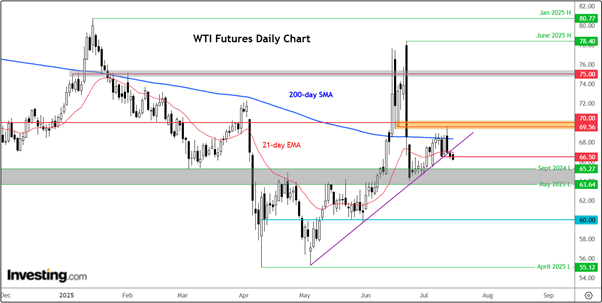ION expands ETF trading capabilities with Tradeweb integration
- WTI crude broke key support levels, signaling a bearish technical setup ahead.
- Traders shrugged off Trump’s tariff threats, betting on delays or de-escalation.
- OPEC+ hikes and fading demand post-driving season may cap any upside in oil.
- Looking for more actionable trade ideas? Subscribe now to unlock access to InvestingPro’s AI-selected stock winners for up to 50% off amid the summer sale.
Oil prices remained on the back foot in early parts of Wednesday’s session. The reversal started on Monday after prices initially spiked higher. But those initial gains evaporated, before oil prices extended their losses slightly further on Tuesday.
Initially, traders had reacted warily to threats of ’very severe’ tariffs against Russia, but realising that those threats were not imminent, they sold oil. WTI was still holding above the $65 barrel, so it wasn’t all doom and gloom. Still, the crude oil outlook is far from bullish, and I continue to expect more sideways chop, with a bearish tilt, in the coming weeks than foreseeing a major rally.
More on the macro factors later, but first let’s talk about the crude oil price chart, which is also painting a bearish picture.
WTI Breaks Trend Support

As per the daily chart of the WTI futures, prices have now broken a short-term bullish trend line after being unable to convincingly break back above the 200-day moving average in the last few sessions. Price hit resistance in the 65.50-70.00 range, which remains as the most important resistance zone moving forward.
Today, WTI is pushing below the $66.50 short-term support level, and a close below here would represent another bearish technical development, aiding the bearish momentum. The next zone of potential support is shaded in grey on the chart between $64-$65 where oil prices had found major lows in the past couple of years. Thereafter, $60 is the next obvious bearish target.
Trump’s Tariff Threats on Russia Shrugged Off - Here’s Why
Donald Trump said he was "very, very unhappy" with Russia and has announced plans to deliver "top-of-the-line" weapons to Ukraine, adding he will introduce "very severe" secondary tariffs of 100% if no ceasefire deal is reached within 50 days.
Traders worried that Trump would target countries buying Russian oil, including India and China. But while it would seem that secondary sanctions on countries buying Russian oil would tighten the market, the fact that oil prices fell suggests investors are relieved that Trump has allowed sufficiently enough time for Putin to agree to a ceasefire.
They are also getting used to Trump threating tariffs, only to change his mind in the last minute and extend deadlines. In other words, the market hasn’t taken Trump’s threats seriously. Either that, or investors are hopeful that Trump will manage to bring Putin and Zelensky to the table and make a ceasefire agreement.
Investors are also still digesting the OPEC’s decision to increase supplies more than expected, so it is not all about Russia.
What Factors Have Supported Oil Prices in Recent Months?
Following the sudden de-escalation in the conflict between Israel and Iran a few weeks ago, we saw oil prices collapse in initial response, as you would expect. Then, prices started to bounce back and while they have sold off a bit, WTI was still holding onto a monthly advance, following sizeable gains in June and May.
It remains to be seen whether those gains can now hold, but what’s behind prior support in oil prices?
Well, the answer lies in a cocktail of easing concerns and seasonal demand dynamics. Initially, markets were rattled by fears that trade tensions would derail global growth and, by extension, energy demand. But such fears have since subsided rather noticeably, as evidenced by a buoyant equities market—benchmark indices such as the S&P 500 have surged from their April troughs to post fresh record highs.
Inflation, which was expected to surge due to higher tariffs, has remained subdued – as we found out with Tuesday’s core CPI reading out of the US. Most central banks, for their part, have been cutting interest rates cautiously, adding a layer of support. Meanwhile, Washington has pushed through a hefty budget and tax package, which—while likely to swell the national debt—should give near-term economic growth a nudge.
On the demand side, we’re entering the US peak driving season, where gasoline consumption tends to spike. So, the outlook for crude oil is not entirely bearish, but the upside should be limited as well.
But What About the OPEC+ Production Hikes?
The group has announced a production hike of 548,000 barrels per day for August—an increase on the 411,000-bpd rises seen over the previous three months. This move effectively brings back nearly half of the 2.2 million-bpd voluntary cuts agreed earlier this year by eight OPEC members. More is expected in September, with Goldman Sachs projecting an additional 550,000 bpd to come online.
Now, the strategic question: was this prudent? OPEC+ is clearly aiming to maintain market share, especially as US output growth has stalled. The Energy Information Administration now expects US oil production to average 13.37 million barrels per day this year, a downward revision from the previous forecast of 13.42 million. The culprit? Softening oil prices have dented drilling activity.
All of which raises an intriguing possibility: OPEC+ may well be seizing the moment—capitalising on a window where US shale is not in full “drill-baby-drill” mode. One could argue this is as good a time as any for the group to flex its muscles and restore some barrels to the market. But by pumping more oil, this is going to weigh on the outlook for prices, as demand post peak driving season is likely to ease back.
***
Be sure to check out InvestingPro to stay in sync with the market trend and what it means for your trading. Leveraging InvestingPro can unlock a world of investment opportunities while minimizing risks amid the challenging market backdrop.
- ProPicks AI: AI-selected stock winners with proven track record.
- InvestingPro Fair Value: Instantly find out if a stock is underpriced or overvalued.
- Advanced Stock Screener: Search for the best stocks based on hundreds of selected filters, and criteria.
- Top Ideas: See what stocks billionaire investors such as Warren Buffett, Michael Burry, and George Soros are buying.

